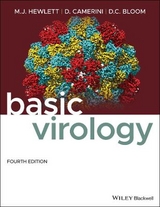
Basic Virology
Wiley-Blackwell (an imprint of John Wiley & Sons Ltd) (Verlag)
978-1-4051-4715-6 (ISBN)
Edward K. Wagner (May 4, 1940 - January 21, 2006) was Professor of Molecular Biology and Biochemistry at the University of California Irvine. Martinez J. Hewlett is Professor Emeritus in the Department of Molecular and Cellular Biology at the University of Arizona. New to this edition, David C. Bloom is Associate Professor in the Department of Molecular Genetics and Microbiology at University of Florida and David Camerini is Assistant Professor in the Department of Molecular Biology and Biochemistry at the University of California Irvine.
Preface to the First Edition. Preface to the Second Edition. Preface to the Third Edition. Acknowledgments. Part I: Virology and Viral Disease. 1. Introduction - the Impact of Viruses on Our View of Life 2. THE SCIENCE OF VIROLOGY. The Effect of Virus Infections on the Host Organism and Populations - Viral Pathogenesis, Virulence, and Epidemiology. The Interaction Between Viruses and Their Hosts. The History of Virology. Examples of the Impact of Viral Disease on Human History. Examples of the Evolutionary Impact of the Virus-Host Interaction. The Origin of Viruses. Viruses Have a Constructive as Well as Destructive Impact on Society. Viruses are Not the Smallest Self-replicating Pathogens. 2. An Outline of Virus Replication and Viral Pathogenesis. VIRUS REPLICATION. Stages of Virus Replication in the Cell. PATHOGENESIS OF VIRAL INFECTION. Stages of Virus-induced Pathology. 3. Virus Disease in Populations and Individual Animals. THE NATURE OF VIRUS RESERVOIRS. Some Viruses with Human Reservoirs. Some Viruses with Vertebrate Reservoirs. VIRUSES IN POPULATIONS. Viral Epidemiology in Small and Large Populations. Factors Affecting the Control of Viral Disease in Populations. ANIMAL MODELS TO STUDY VIRAL PATHOGENESIS. A Mouse Model for Studying Poxvirus Infection and Spread. Rabies: Where is the Virus During its Long Incubation Period?. Herpes Simplex Virus Latency. 4. Patterns of Some Viral Diseases of Humans. The Stable Association of Viruses with their Natural Host Places Specific Constraints on the Nature of Viral Disease and Mode of Persistence. Classification of Human Disease-Causing Viruses According to Virus-Host Dynamics. PATTERNS OF SPECIFIC VIRAL DISEASES OF HUMANS. Acute Infections Followed by Virus Clearing. Infection of an "Accidental" Target Tissue Leading to Permanent Damage Despite Efficient Clearing. Persistent Viral Infections. Viral and Subviral Diseases with Long Incubation Periods. SOME VIRAL INFECTIONS TARGETING SPECIFIC ORGAN SYSTEMS. Viral Infections of Nerve Tissue. Examples of Viral Encephalitis with Grave Prognosis. Viral Encephalitis with Favorable Prognosis for Recovery. Viral Infections of the Liver (Viral Hepatitis). PROBLEMS FOR PART I. ADDITIONAL READING FOR PART I. Part II: Basic Properties of Viruses and Virus-Cell Interaction. 5. Virus Structure and Classification. THE FEATURES OF A VIRUS. Viral Genomes. Viral Capsids. Viral Envelopes. CLASSIFICATION SCHEMES. The Baltimore Scheme of Virus Classification. Disease-based Classification Schemes for Viruses. THE VIROSPHERE. 6. The Beginning and End of the Virus Replication Cycle. Outline of the Virus Replication Cycle. VIRAL ENTRY. Mechanisms of Entry of Nonenveloped Viruses. Entry of Enveloped Viruses. Entry of Virus into Plant Cells. Injection of Bacteriophage DNA into Escherichia coli. Nonspecific Methods of Introducing Viral Genomes into Cells. LATE EVENTS IN VIRAL INFECTION: CAPSID ASSEMBLY AND VIRION RELEASE. Assembly of Helical Capsids. Assembly of Icosahedral Capsids. Generation of the Virion Envelope and Egress of the Enveloped Virion. 7. Host Immune Response to Viral Infection - The Nature of the Vertebrate Immune Response. THE INNATE IMMUNE RESPONSE - EARLY DEFENSE AGAINST PATHOGENS. Toll-like Receptors. Defensins. THE ADAPTIVE IMMUNE RESPONSE AND THE LYMPHATIC SYSTEM. Two Pathways of Helper T Response: the Fork in the Road. The Immunological Structure of a Protein. Role of the Antigen-presenting Cell in Initiation of the Immune Response. CONTROL AND DYSFUNCTION OF IMMUNITY. Specific Viral Responses to Host Immunity. Consequences of Immune Suppression to Virus Infections. MEASUREMENT OF THE IMMUNE REACTION. Measurement of Cell-mediated (T-cell) Immunity. Measurement of Antiviral Antibody. 8. Strategies to Protect Against and Combat Viral Infection. VACCINATION - INDUCTION OF IMMUNITY TO PREVENT VIRUS INFECTION. Antiviral Vaccines. Smallpox and the History of Vaccination. How a Vaccine is Produced. Problems with Vaccine Production and Use. EUKARYOTIC CELL-BASED DEFENSES AGAINST VIRUS REPLICATION. Interferon. Other Cellular Defenses against Viral Infection. ANTIVIRAL DRUGS. Targeting Antiviral Drugs to Specific Features of the Virus Replication Cycle. Other Approaches. BACTERIAL ANTIVIRAL SYSTEMS - RESTRICTION ENDONUCLEASES. PROBLEMS FOR PART II. ADDITIONAL READING FOR PART II. Part III: Working with Virus. 9. Visualization and Enumeration of Virus Particles. Using the Electron Microscope to Study and Count Viruses. Atomic Force Microscopy - A Rapid and Sensitive Method for Visualization of Viruses and Infected Cells, Potentially in Real Time. Indirect Methods for "Counting" Virus Particles. 10. Replicating and Measuring Biological Activity of Viruses. Cell Culture Techniques. Culture of Animal and Human Cells. THE OUTCOME OF VIRUS INFECTION IN CELLS. Fate of the Virus. Fate of the Cell Following Virus Infection. MEASUREMENT OF THE BIOLOGICAL ACTIVITY OF VIRUSES. Quantitative Measure of Infectious Centers. Use of Virus Titers to Quantitatively Control Infection Conditions. Dilution Endpoint Methods. 11. Physical and Chemical Manipulation of the Structural Components of Viruses. Viral Structural Proteins. Isolation of Structural Proteins of the Virus. Size Fractionation of Viral Structural Proteins. CHARACTERIZING VIRAL GENOMES. Sequence Analysis of Viral Genomes. Measuring the Size of Viral Genomes. The Polymerase Chain Reaction - Detection and Characterization of Extremely Small Quantities of Viral Genomes or Transcripts. 12. Characterization of Viral Products Expressed in the Infected Cell. CHARACTERIZATION OF VIRAL PROTEINS IN THE INFECTED CELL. Pulse Labeling of Viral Proteins at Different Times Following Infection. Use of Immune Reagents for Study of Viral Proteins. DETECTING AND CHARACTERIZING VIRAL NUCLEIC ACIDS IN INFECTED CELLS. Characterization of Viral mRNA Expressed During Infection. USE OF MICROARRAY TECHNOLOGY FOR GETTING A COMPLETE PICTURE OF THE EVENTS OCCURRING IN THE INFECTED CELL. 13. Viruses Use Cellular Processes to Express Their Genetic Information. Prokaryotic DNA Replication is an Accurate Enzymatic Model for the Process Generally. Expression of mRNA. Prokaryotic Transcription. Eukaryotic Transcription. The Mechanism of Protein Synthesis. PROBLEMS FOR PART III. ADDITIONAL READING FOR PART III. Part IV: Replication Patterns of Specific Viruses. 14. Replication of Positive-sense RNA Viruses. RNA VIRUSES - GENERAL CONSIDERATIONS. A General Picture of RNA-Directed RNA Replication. REPLICATION OF POSITIVE-SENSE RNA VIRUSES WHOSE GENOMES ARE TRANSLATED AS THE FIRST STEP IN GENE EXPRESSION. POSITIVE-SENSE RNA VIRUSES ENCODING A SINGLE LARGE OPEN READING FRAME. Picornavirus Replication. Flavivirus Replication. Positive-sense RNA Viruses Encoding More than One Translational Reading Frame. Two Viral mRNAs are Produced in Different Amounts During Togavirus Infections. A Somewhat More Complex Scenario of Multiple Translational Reading Frames and Subgenomic mRNA Expression: Coronavirus Replication. REPLICATION OF PLANT VIRUSES WITH RNA GENOMES. Viruses with One Genome Segment. Viruses with Two Genome Segments. Viruses with Three Genome Segments. REPLICATION OF BACTERIOPHAGE WITH RNA GENOMES. Regulated Translation of Bacteriophage mRNA. 15. Replication Strategies of RNA Viruses Requiring RNA-directed mRNA Transcription as the First Step in Viral Gene Expression. Paramyxoviruses. Filoviruses and their Pathogenesis. Bornaviruses. INFLUENZA VIRUSES - NEGATIVE-SENSE RNA VIRUSES WITH A MULTIPARTITE GENOME. Involvement of the Nucleus in Flu Virus Replication. Generation of New Flu Nucleocapsids and Maturation of the Virus. Influenza A Epidemics. OTHER NEGATIVE-SENSE RNA VIRUSES WITH MULTIPARTITE GENOMES. Bunyaviruses. Arenaviruses. VIRUSES WITH DOUBLE-STRANDED RNA GENOMES. Reovirus Structure. Reovirus Replication Cycle. Pathogenesis. SUBVIRAL PATHOGENS. Hepatitis Delta Virus. Viroids. Prions. 16. Replication Strategies of Small and Medium-sized DNA Viruses. DNA Viruses Express Genetic Information and Replicate Their Genomes in Similar, Yet Distinct, Ways. Papovavirus Replication. Replication of SV40 Virus - The Model Polyomavirus. Replication of Papillomaviruses. Replication of Adenoviruses. Physical Properties of Adenovirus. The Adenovirus Replication Cycle. Replication of Some Single-stranded DNA Viruses. Replication of Parvoviruses. DNA Viruses Infecting Vascular Plants. Single-stranded DNA Bacteriophage X174 Packages its Genes Very Compactly. 17. Replication of Some Nuclear-replicating Eukaryotic DNA Viruses with Large Genomes. HERPESVIRUS REPLICATION AND LATENCY. The Herpesviruses as A Group. The Replication of the Prototypical Alpha-Herpesvirus - HSV. HSV Latency and LAT. EBV Latent Infection of Lymphocytes, A Different Set of Problems and Answers. Pathology of Herpesvirus Infections. BACULOVIRUS, AN INSECT VIRUS WITH IMPORTANT PRACTICAL USES IN MOLECULAR BIOLOGY. Virion Structure. Viral Gene Expression and Genome Replication. Pathogenesis. Importance of Baculoviruses in Biotechnology. 18. Replication of Cytoplasmic DNA Viruses and "Large" Bacteriophages. POXVIRUSES - DNA VIRUSES THAT REPLICATE IN THE CYTOPLASM OF EUKARYOTIC CELLS. The Pox Virion is Complex and Contains Virus-coded Transcription Enzymes. The Poxvirus Replication Cycle. Pathogenesis and History of Poxvirus Infections. Is Smallpox Virus A Potential Biological Terror Weapon?. REPLICATION OF "LARGE" DNA-CONTAINING BACTERIOPHAGES. Components of Large DNA-containing Phage Virions. Replication of Phage T7. T4 Bacteriophage: the Basic Model for All DNA Viruses. Replication of Phage : a "Simple" Model for Latency and Reactivation. A GROUP OF ALGAL VIRUSES SHARES FEATURES OF ITS GENOME STRUCTURE WITH POXVIRUSES AND BACTERIOPHAGES. 19. Retroviruses: Converting RNA to DNA. RETROVIRUS FAMILIES AND THEIR STRATEGIES OF REPLICATION. The Molecular Biology of Retrovirus. Replication of Retroviruses: An Outline of the Replication Process. Viral Gene Expression, Assembly, and Maturation. MECHANISMS OF RETROVIRUS TRANSFORMATION. Transformation through the Action of A Viral Oncogene - A Subverted Cellular Growth Control Gene. Oncornavirus Alteration of Normal Cellular Transcriptional Control of Growth Regulation. Oncornavirus Transformation by Growth Stimulation of Neighboring Cells. CELLULAR GENETIC ELEMENTS RELATED TO RETROVIRUSES. Retrotransposons. The Relationship Between Transposable Elements and Viruses. 20. Human Immunodeficiency Virus Type 1 (HIV-1) and Related Lentiviruses. HIV-1 and Related Lentiviruses. The Origin of HIV-1 and AIDS. HIV-1 and Lentiviral Replication. Destruction of the Immune System by HIV-1. 21. Hepadnaviruses: Variations on the Retrovirus Theme. The Virion and the Viral Genome. The Viral Replication Cycle. The Pathogenesis of Hepatitis B Virus. A Plant "Hepadnavirus": Cauliflower Mosaic Virus. The Evolutionary Origin of Hepadnaviruses. PROBLEMS FOR PART IV. ADDITIONAL READING FOR PART IV. PART V: Viruses: New Approaches and New Problems. 22. The Molecular Genetics of Viruses. Mutations in Genes and Resulting Changes to Proteins. Analysis of Mutations. Isolation of Mutants. A TOOL KIT FOR MOLECULAR VIROLOGISTS. Viral Genomes. Locating Sites of Restriction Endonuclease Cleavage On the Viral Genome - Restriction Mapping. Cloning Vectors. Directed Mutagenesis of Viral Genes. Generation of Recombinant Viruses. 23. Molecular Pathogenesis. AN INTRODUCTION TO THE STUDY OF VIRAL PATHOGENESIS. ANIMAL MODELS. Choosing a model: Natural Host vs. Surrogate Models. Development of New Models: Transgenic Animals. Hybrid Models: the SCID-hu Mouse. Considerations Regarding the Humane Use of Animals. METHODS FOR THE STUDY OF PATHOGENESIS. Assays of Virulence. Analysis of Viral Spread within the Host. Resolving the Infection to the Level of Single Cells. CHARACTERIZATION OF THE HOST RESPONSE. Immunological Assays. Use of Transgenic Mice to Dissect Critical Components of the Host Immune Response That Modulate the Viral Infection. 24. Viral Bioinformatics and Beyond. BIOINFORMATICS. Bioinformatics and Virology. BIOLOGICAL DATABASES. Primary Databases. Secondary Databases. Composite Databases. Other Databases. BIOLOGICAL APPLICATIONS. Similarity Searching Tools. Protein Functional Analysis. Sequence Analysis. Structural Modeling. Structural Analysis. SYSTEMS BIOLOGY AND VIRUSES. VIRAL INTERNET RESOURCES. 25. Viruses and the Future - Promises and Problems. Clouds on the Horizon - Emerging Disease. What are the Prospects of Using Medical Technology to Eliminate Specific Viral and Other Infectious Diseases?. Silver Linings - Viruses as Therapeutic Agents. Why Study Virology?. PROBLEMS FOR PART V. ADDITIONAL READING FOR PART V. Appendix: Resource Center. Books of Historical and Basic Value. Books on Virology. Molecular Biology and Biochemistry Texts. Detailed Sources. Sources for Experimental Protocols. The Internet. Technical Glossary. Index
| Erscheint lt. Verlag | 5.10.2007 |
|---|---|
| Verlagsort | Chicester |
| Sprache | englisch |
| Maße | 219 x 276 mm |
| Gewicht | 1538 g |
| Einbandart | kartoniert |
| Themenwelt | Naturwissenschaften ► Biologie ► Mikrobiologie / Immunologie |
| ISBN-10 | 1-4051-4715-6 / 1405147156 |
| ISBN-13 | 978-1-4051-4715-6 / 9781405147156 |
| Zustand | Neuware |
| Haben Sie eine Frage zum Produkt? |
aus dem Bereich



